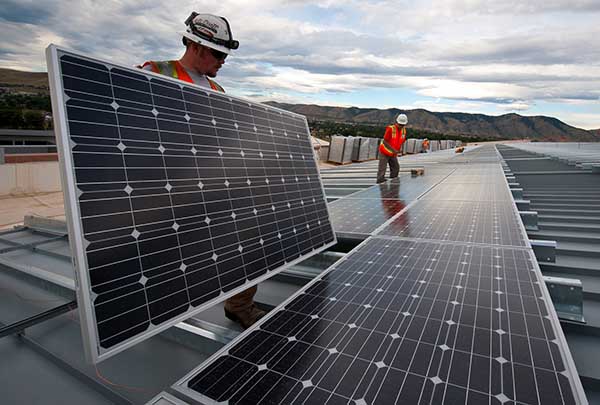Utilities have been trading wholesale energy for decades among one another, but these markets are beginning to play a larger role as utilities adopt more renewables and see the benefits of regional collaboration.
With the Western Energy Imbalance Market, utilities across the Southwest and West are collaborating to efficiently serve their customers. This market has grown increasingly useful for states like California as it adopts more renewable energy, which has been benefitting Arizona in turn.
The Western Energy Imbalance Market (EIM) is a wholesale energy trading market that allows participating utilities around the West to buy and sell energy among one another. If one market is generating too much energy, it can sell its energy to the market next door.
California ISO launched the western EIM in 2014 with Oregon-based PacifiCorp joining as the first utility participant. Then, Las Vegas-based NV Energy joined in late 2015, Arizona Public Service and Bellevue, Wash.-based Puget Sound Energy joined in October 2016 and Portland General Electric joined in November 2017.
Buy low, sell high
Since joining the EIM, APS has seen benefits beyond what it initially forecast before joining the market, says Brad Albert, vice president of resource management at APS.
“It’s been, overall, a good experience that’s contributed some significant savings to our customers,” Albert says. After its first full year participating in the EIM, APS saved $30.5 million, which was passed on to the customers, the utility states.
APS is able to purchase cheap or negative-priced energy from California, especially during this time of the year, by participating in the EIM, Albert says.
California has developed an over-abundance of PV solar energy, which often leads to the state having too much power during the middle of the day when the sun is up. So Arizona occasionally gets paid to use that energy, or purchases that power at a cheaper rate than what it would cost APS to generate its own power in Arizona.
So, in the middle of the day, APS will be importing California’s overproduction of renewable energy to Arizona, Albert says.
When the sun eventually goes down, those renewables aren’t producing as much energy and customer demand is at its highest. That’s when utilities like APS can start exporting energy to California in those early evening hours at “significantly higher prices than what we produce,” which is the other source of APS’ savings that stem from the EIM, Albert says.
This doesn’t happen every day, Albert mentions, but it does happen often during the hotter parts of the year.
APS has always participated in wholesale energy markets, Albert says, but the EIM is a bit different.
“The energy imbalance market took (energy trading) to another plateau, another level, because it helps to facilitate more efficient trading activity. It’s more automated,” Albert says.
For APS, participating in the Energy Imbalance Market is about efficiency and how the utility can pass on savings to customers by purchasing cheaper energy. APS imports energy from cheaper sources more often than it exports energy, Albert explains. The utility is focused on bringing the best benefits to its customers by participating in this wider market.
The Salt River Project currently has plans to join the California ISO Energy Imbalance Market by April 2020.
SRP is gearing up its IT and software tools to start communicating with the other utilities in the EIM, says Mike Clester, manager of power supply and trading at SRP.
SRP expects to see the same types of revenues and cost savings that APS is currently experiencing through its participation in the EIM, Clester says.
Engaging in the EIM won’t be SRP’s first time operating in the wholesale energy markets. By participating in the EIM, SRP will be fine-tuning its operations to get that last piece of possible sales opportunities and revenue, Clester says.
SRP will have access to one generator in another market that may be cheaper than one of its own generators, Clester says.
“That’s the operational excellence piece of it, that we’re really running our system as optimally as we possibly can. That’s going to save us money and make us money,” Clester says.
Participating in the EIM will also enable further addition of renewable energies into SRP’s portfolio, Clester says. Instead of always calling on natural gas generators to keep up with the fluctuation of loads when renewables become intermittent, SRP will have a bigger pool of resources to pull from in the EIM, Clester says.
“All together, we can better handle those deviations in generation,” from renewables, he says.
Growing markets
The western EIM is set to grow beyond SRP’s looming entrance and two recent additions in April.
Seattle City Light, Los Angeles Department of Power & Water and the Balancing Authority of Northern California/SMUD are all slated to join the EIM between 2019 and 2020 alongside SRP.
Since California has been an early adopter of renewable power sources, like PV solar, the state has embarked sooner into this wider regional market than other places to combat against renewable intermittency issues, Clester says.
“(California utilities) needed help from their neighboring utilities, so they’ve actually asked us again to help with this issue,” Clester says about participating in the EIM and its future growth.
As time moves on and SRP adopts more renewables, the market will need to grow more, Clester says. No one has announced plans to join the EIM since SRP’s announcement, but Clester imagines there will be more utilities joining beyond 2020.
With the possibility of wider adoption and growth of the western EIM, and this idea of a regional grid, the leaders at the Arizona Energy Consortium wish to make sure that Arizona’s voice and priorities are heard.
“Arizona stakeholders need to maintain a seat at the table where the expansion of the CAISO and other regional issues are being discussed,” says Michelle De Blasi, co-executive director of the Arizona Energy Consortium and director at Fennemore Craig. “As the markets evolve, it is imperative Arizona contributes to the conversation. We cannot afford to have decisions impacting Arizona and its ratepayers being made by those outside the state.”
De Blasi mentions that leaders in California may have ideas on how Arizona participates in such a way that influence’s the state’s energy mix. And this could have an impact on Arizona’s utility rates, she says.
Chris Davey, co-executive director of the Arizona Energy Consortium, says Arizona needs to be thinking about how the state benefits from participation in a regional energy market and focusing how the market could be a win-win for everybody.
In order to do that, say Davey and De Blasi, Arizona needs to ensure it has a seat at the table and that its needs are considered.
Local utilities are working within the EIM on a voluntary basis, aiming to exceed the maximum benefit and efficiency for Arizona customers.
“It’s a market that is providing (APS) benefits, and we’re able to derive efficiencies from it. But it’s a voluntary market. We can dial in and adjust how we participate in that market, so we can make sure that it is always serving the interests of Arizona customers first,” Albert says.
Connecting the Southwest
With more energy trading happening and the possibility of the market growing even more over time, are Arizona’s transmission lines up to the task?
Arizona’s connection with California is robust, SRP’s Clester says, but the connections with the Eastern part of the state and beyond aren’t as large.
There are projects on the horizon that will add more lines in and connections in Arizona.
The SunZia Southwest Transmission Project consists of two 500kV transmission lines and substations and will run more than 500 miles from New Mexico to Arizona.
The lines in New Mexico will stem from wind-energy rich areas and will deliver energy across the Southwest.
There’s also the Southline Transmission Project, which is aiming to add a route along existing corridors of transmission lines from south of Las Cruces, New Mexico and south of Willcox, Arizona while upgrading lines where possible.
Upgrades are becoming an important piece of creating the Southwest into a larger, regional market.
Davey says that much like the U.S. transportation infrastructure, the transmission system is in need of upgrades. He mentions the large amount of activity with projects like Southline, SunZia and the Ten West Link, are evidence of the need for more upgrades in energy infrastructure.
“If regional play comes to fruition, in order for Arizona to best capitalize on that and take advantage fiscally and from improved efficiencies, we need to ensure our in-state transmission system supports everything going around us,” Davey says.




